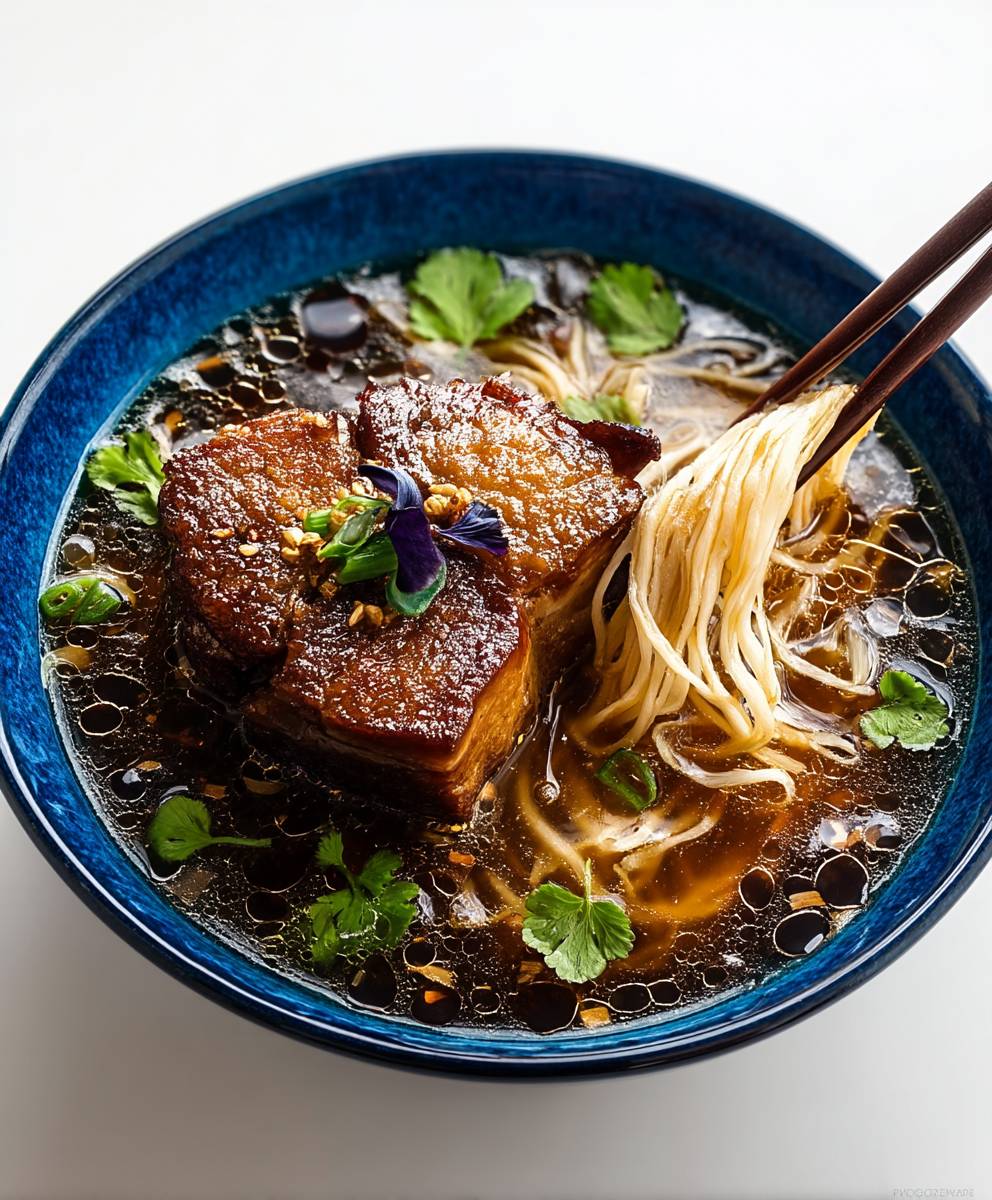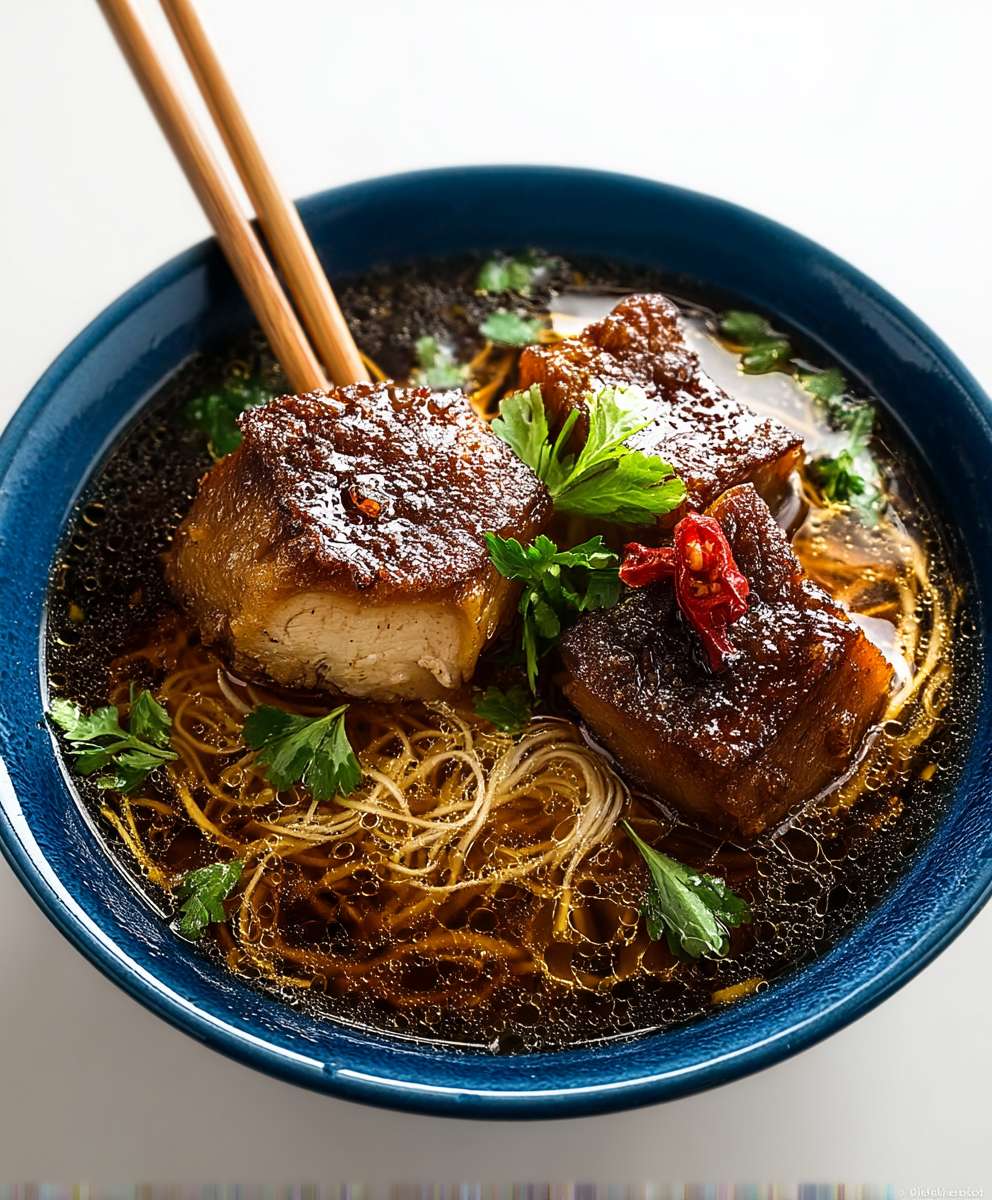Vietnamese Caramelized Pork, or Thit Kho Tau, is a dish that whispers of home, family gatherings, and the rich culinary heritage of Vietnam. Imagine tender, melt-in-your-mouth pork belly simmered in a sweet and savory caramel sauce, infused with the subtle warmth of fish sauce and the gentle bite of black pepper. Are you already drooling? I know I am just thinking about it!
This iconic dish isn’t just about incredible flavor; it’s a cultural cornerstone. Thit Kho Tau is traditionally prepared during T?t, the Vietnamese Lunar New Year, symbolizing prosperity and good fortune for the year ahead. Passed down through generations, each family boasts their own unique twist on this beloved recipe, making it a deeply personal and cherished part of their traditions.
What makes Vietnamese Caramelized Pork so irresistible? It’s the perfect balance of sweet, salty, and savory. The pork belly becomes unbelievably tender after hours of slow simmering, absorbing all the delicious flavors of the caramel sauce. The slight sweetness of the caramel perfectly complements the richness of the pork, while the fish sauce adds a depth of umami that keeps you coming back for more. It’s also a relatively simple dish to prepare, making it a comforting and satisfying meal for any occasion. So, let’s get cooking and bring a taste of Vietnam to your kitchen!

Ingredients:
- 2 lbs pork belly, skin on or off, cut into 1-inch cubes
- 1 large yellow onion, roughly chopped
- 4 cloves garlic, minced
- 1-inch piece of ginger, peeled and thinly sliced
- 2 stalks lemongrass, bruised
- 1/2 cup granulated sugar
- 1/4 cup fish sauce (nuoc mam)
- 2 tablespoons soy sauce
- 1 tablespoon dark soy sauce (optional, for color)
- 1 teaspoon black pepper
- 1/2 teaspoon red pepper flakes (optional, for heat)
- 2 cups water or coconut water
- 2 tablespoons vegetable oil
- Cooked rice, for serving
- Optional garnishes: sliced scallions, cilantro, sliced chili peppers
Preparing the Pork:
- Prepare the pork belly. If your pork belly has the skin on, you can choose to leave it on or remove it. Leaving the skin on will result in a chewier texture, while removing it will make the pork more tender. Cut the pork belly into 1-inch cubes. This size is ideal for even cooking and allows the pork to absorb the flavorful sauce.
- Blanch the pork (optional but recommended). Bring a pot of water to a boil. Add the pork belly cubes and blanch for about 5 minutes. This helps to remove impurities and excess fat, resulting in a cleaner and more flavorful dish. Drain the pork and rinse it under cold water. Pat it dry with paper towels.
Making the Caramel:
- Caramelize the sugar. This is the most crucial step, so pay close attention! In a heavy-bottomed pot or Dutch oven (I prefer a Dutch oven for even heat distribution), add the granulated sugar. Place the pot over medium heat. Do not stir the sugar initially. Let it melt slowly and evenly.
- Watch for color changes. As the sugar melts, it will start to turn golden brown. Keep a close eye on it, as it can burn quickly. Once the sugar is completely melted and a deep amber color, carefully add 2 tablespoons of water. Be very careful, as the caramel will splatter and steam vigorously.
- Stir to dissolve. Stir the mixture constantly until the caramel is smooth and all the sugar crystals have dissolved. The caramel should be a rich, dark brown color. If it seizes up, continue stirring over low heat until it melts again.
Cooking the Pork:
- Sauté the aromatics. Add the vegetable oil to the pot with the caramel. Heat over medium heat. Add the chopped onion, minced garlic, sliced ginger, and bruised lemongrass. Sauté for about 5-7 minutes, or until the onions are softened and fragrant. The aromatics will infuse the oil with their flavors, creating a delicious base for the dish.
- Brown the pork. Add the pork belly cubes to the pot and brown them on all sides. This step is important for developing flavor and adding a nice sear to the pork. Work in batches if necessary to avoid overcrowding the pot.
- Add the seasonings. Pour in the fish sauce, soy sauce, and dark soy sauce (if using). Add the black pepper and red pepper flakes (if using). Stir well to coat the pork evenly with the seasonings.
- Simmer the pork. Pour in the water or coconut water. Bring the mixture to a simmer, then reduce the heat to low. Cover the pot and let the pork simmer for at least 1.5 to 2 hours, or until the pork is very tender and the sauce has thickened. Stir occasionally to prevent sticking.
- Check for tenderness. After 1.5 hours, check the pork for tenderness. It should be easily pierced with a fork. If it’s not tender enough, continue simmering for another 30 minutes or until it reaches the desired tenderness.
- Adjust the sauce. If the sauce is too thin, remove the lid and simmer for a few more minutes to reduce it to your desired consistency. If the sauce is too thick, add a little more water or coconut water. Taste and adjust the seasonings as needed. You may want to add a little more fish sauce for saltiness or a pinch of sugar for sweetness.
- Remove lemongrass. Before serving, remove the bruised lemongrass stalks from the pot.
Serving:
- Serve hot. Serve the Vietnamese Caramelized Pork hot over cooked rice. The rice will soak up the delicious sauce, making each bite incredibly flavorful.
- Garnish (optional). Garnish with sliced scallions, cilantro, and sliced chili peppers for added flavor and visual appeal.
Tips for Success:
- Use good quality fish sauce. The quality of the fish sauce will greatly impact the flavor of the dish. Look for a fish sauce that is made with only anchovies and salt.
- Don’t burn the caramel. Burning the caramel will result in a bitter taste. Keep a close eye on it and remove it from the heat as soon as it reaches a deep amber color.
- Be patient. The longer the pork simmers, the more tender and flavorful it will become. Don’t rush the cooking process.
- Adjust the seasonings to your liking. Taste the sauce and adjust the seasonings as needed. You may want to add more fish sauce, sugar, or chili peppers to suit your taste.
- Coconut water adds a subtle sweetness. Using coconut water instead of regular water will add a subtle sweetness and richness to the dish.
- Make it ahead of time. This dish can be made ahead of time and reheated. The flavors will actually meld together even more overnight.
Variations:
- Add eggs. Hard-boiled eggs can be added to the pot during the last 30 minutes of cooking. They will absorb the flavorful sauce and become incredibly delicious.
- Add tofu. For a vegetarian version, substitute the pork belly with firm tofu. Press the tofu to remove excess water, then cut it into cubes and brown it in the pot before adding the other ingredients.
- Add pineapple. Adding chunks of pineapple during the last 30 minutes of cooking will add a sweet and tangy flavor to the dish.
- Spicy version. Increase the amount of red pepper flakes or add a chopped chili pepper to the pot for a spicier version.
Storage:
- Refrigerate. Leftover Vietnamese Caramelized Pork can be stored in an airtight container in the refrigerator for up to 3-4 days.
- Reheat. Reheat the pork in a saucepan over medium heat or in the microwave until heated through.

Conclusion:
This Vietnamese Caramelized recipe is truly a game-changer, and I wholeheartedly believe it deserves a permanent spot in your culinary repertoire. The depth of flavor achieved through the simple yet strategic combination of ingredients is simply astounding. It’s that perfect balance of sweet, savory, and umami that keeps you coming back for more, bite after bite. Forget bland weeknight dinners; this dish injects a vibrant burst of Southeast Asian flair into your kitchen, transforming ordinary ingredients into something extraordinary.
Why is it a must-try? Because it’s incredibly versatile, surprisingly easy to make, and delivers restaurant-quality results without the restaurant price tag. You don’t need to be a seasoned chef to master this recipe. The steps are straightforward, and the reward is immense. Plus, the aroma that fills your kitchen as the caramel simmers is simply intoxicating a promise of the deliciousness to come.
But the beauty of this recipe lies not only in its simplicity and flavor but also in its adaptability. Feel free to experiment with different protein options. While I’ve highlighted chicken, this method works beautifully with pork belly, tofu, or even shrimp. For a vegetarian twist, try using firm tofu, pressing out the excess water before caramelizing it. You can also add vegetables like bell peppers, onions, or mushrooms to the pan during the last few minutes of cooking for added texture and nutrition.
Serving suggestions are endless! I personally love serving this Vietnamese Caramelized chicken over a bed of fluffy jasmine rice, garnished with fresh cilantro and a sprinkle of sesame seeds. A side of steamed bok choy or stir-fried greens complements the richness of the dish perfectly. For a more casual meal, try serving it in lettuce wraps with pickled carrots and daikon for a refreshing crunch. Or, get creative and use it as a filling for banh mi sandwiches the possibilities are truly limitless!
Don’t be afraid to adjust the sweetness or saltiness to your liking. Taste as you go and add a little more fish sauce or sugar until you achieve your desired balance. A squeeze of lime juice at the end can also brighten up the flavors and add a touch of acidity.
I’m so confident that you’ll love this recipe as much as I do. It’s a guaranteed crowd-pleaser, perfect for weeknight dinners, special occasions, or even meal prepping. It reheats beautifully, making it a convenient option for busy schedules.
So, what are you waiting for? Gather your ingredients, put on some music, and get ready to embark on a culinary adventure. I promise you won’t be disappointed.
And most importantly, I want to hear about your experience! Once you’ve tried this recipe, please come back and share your thoughts in the comments below. Did you make any modifications? What did you serve it with? What did your family think? Your feedback is invaluable and helps me continue to improve and share recipes that you’ll love. Happy cooking! I can’t wait to see what delicious creations you come up with using this fantastic Vietnamese Caramelized base. Let’s get cooking!
Vietnamese Caramelized: A Delicious and Easy Recipe
Tender pork belly simmered in a rich, savory-sweet caramel sauce with aromatic ginger, garlic, and lemongrass. A classic Vietnamese comfort food.
Ingredients
- 2 lbs pork belly, skin on or off, cut into 1-inch cubes
- 1 large yellow onion, roughly chopped
- 4 cloves garlic, minced
- 1-inch piece of ginger, peeled and thinly sliced
- 2 stalks lemongrass, bruised
- 1/2 cup granulated sugar
- 1/4 cup fish sauce (nuoc mam)
- 2 tablespoons soy sauce
- 1 tablespoon dark soy sauce (optional, for color)
- 1 teaspoon black pepper
- 1/2 teaspoon red pepper flakes (optional, for heat)
- 2 cups water or coconut water
- 2 tablespoons vegetable oil
- Cooked rice, for serving
- Optional garnishes: sliced scallions, cilantro, sliced chili peppers
Instructions
- Prepare the pork belly. If your pork belly has the skin on, you can choose to leave it on or remove it. Leaving the skin on will result in a chewier texture, while removing it will make the pork more tender. Cut the pork belly into 1-inch cubes.
- Blanch the pork (optional but recommended). Bring a pot of water to a boil. Add the pork belly cubes and blanch for about 5 minutes. Drain the pork and rinse it under cold water. Pat it dry with paper towels.
- Caramelize the sugar. In a heavy-bottomed pot or Dutch oven, add the granulated sugar. Place the pot over medium heat. Do not stir the sugar initially. Let it melt slowly and evenly.
- Watch for color changes. As the sugar melts, it will start to turn golden brown. Keep a close eye on it, as it can burn quickly. Once the sugar is completely melted and a deep amber color, carefully add 2 tablespoons of water. Be very careful, as the caramel will splatter and steam vigorously.
- Stir to dissolve. Stir the mixture constantly until the caramel is smooth and all the sugar crystals have dissolved. The caramel should be a rich, dark brown color. If it seizes up, continue stirring over low heat until it melts again.
- Sauté the aromatics. Add the vegetable oil to the pot with the caramel. Heat over medium heat. Add the chopped onion, minced garlic, sliced ginger, and bruised lemongrass. Sauté for about 5-7 minutes, or until the onions are softened and fragrant.
- Brown the pork. Add the pork belly cubes to the pot and brown them on all sides. Work in batches if necessary to avoid overcrowding the pot.
- Add the seasonings. Pour in the fish sauce, soy sauce, and dark soy sauce (if using). Add the black pepper and red pepper flakes (if using). Stir well to coat the pork evenly with the seasonings.
- Simmer the pork. Pour in the water or coconut water. Bring the mixture to a simmer, then reduce the heat to low. Cover the pot and let the pork simmer for at least 1.5 to 2 hours, or until the pork is very tender and the sauce has thickened. Stir occasionally to prevent sticking.
- Check for tenderness. After 1.5 hours, check the pork for tenderness. It should be easily pierced with a fork. If it’s not tender enough, continue simmering for another 30 minutes or until it reaches the desired tenderness.
- Adjust the sauce. If the sauce is too thin, remove the lid and simmer for a few more minutes to reduce it to your desired consistency. If the sauce is too thick, add a little more water or coconut water. Taste and adjust the seasonings as needed.
- Remove lemongrass. Before serving, remove the bruised lemongrass stalks from the pot.
- Serve hot. Serve the Vietnamese Caramelized Pork hot over cooked rice.
- Garnish (optional). Garnish with sliced scallions, cilantro, and sliced chili peppers for added flavor and visual appeal.
Notes
- Use good quality fish sauce.
- Don’t burn the caramel.
- Be patient. The longer the pork simmers, the more tender and flavorful it will become.
- Adjust the seasonings to your liking.
- Coconut water adds a subtle sweetness.
- This dish can be made ahead of time and reheated.
- Variations: Add hard-boiled eggs, tofu (for vegetarian), or pineapple.
- For a spicier version, increase the amount of red pepper flakes or add a chopped chili pepper.
- Storage: Refrigerate leftovers for up to 3-4 days. Reheat in a saucepan or microwave.




Leave a Comment